Bangai-O Spirits
| Bangai-O Spirits | |
|---|---|
 | |
| Developer(s) | Treasure |
| Publisher(s) |
‹See Tfd›
|
| Director(s) | Mitsuru Yaida |
| Designer(s) | Makoto Ogino |
| Composer(s) | Norio Hanzawa |
| Platform(s) | Nintendo DS |
| Release date(s) |
‹See Tfd› |
| Genre(s) | "Missile Action" |
| Mode(s) | Single player, Multiplayer |
Bangai-O Spirits[1] is an action game for the Nintendo DS, and the sequel to Bangai-O which was released on the Nintendo 64 and Dreamcast.
Bangai-O Spirits is a side-scrolling shooting game with free-scrolling levels that extend horizontally and vertically. The player controls a robot with the ability to fly, but is still affected by gravity. He has seven weapons to choose from, and can perform melee attacks using a baseball bat or sword.
The game has 160 levels, and features a level editor to create more. Edited levels can be encoded in a sound that can be recorded with a computer and shared between players. This technology was inspired by the datacasettes used by some older computers, including the Sharp X1 on which Matsumoto learned to program.
Plot
Bangai-O Spirits has very little story line, and is not part of the same continuity as the previous game. The two new pilots are called Masato (boy) and Ruri (girl). The campaign mode is limited to a brief set of tutorial stages.
Upon completing all of the stages under "Treasure's Best" in free mode, a brief cutscene will play, with one of the characters saying "We're only here because the fanboys would throw a fit on the internet if the game didn't have an ending."
Production
In a rare breach of the company's usual secrecy about future plans, developer Yoshiyuki Matsumoto first hinted at a sequel to Bangai-O in a 2003 interview on Sega's website to promote the game Astro Boy: Omega Factor. When asked what game he would like to create next, he said he would like to "carry out Bakuretsu Muteki Bangai-O's revenge." [2]
Treasure began working on a concept demo before a publisher was involved. Full production followed the completion of their previous handheld release, Bleach: Dark Souls. When publisher ESP approached them about a possible collaboration, Bangai-O seemed like a logical fit.[3] On September 11, 2007, Weekly Famitsu announced the game officially, and it was demonstrated at Tokyo Game Show later that month.
Localization
On August 12, 2008, the game has been released in North American by D3 Publisher of America.
Treasure has handled the localization for the game in-house, adding features they did not have time to include in the Japanese release.[4] Treasure previously did this with the North American version of Astro Boy: Omega Factor, which featured new enemies, difficulty modes, and refined level layouts, and is generally considered a stronger product than the original Japanese version.
Gameplay
Weapons
The player is able to choose two weapons from a list that includes various missiles, melee weapons, and a defensive shield.
EX Weapons
The player is also able to choose two EX weapons from a list of homing, napalm, rebound, break, direction, reflector, and freeze. The use of the EX Attack unleashes loads of missiles. More missiles will be fired the longer one charges the attack, and the closer one is to enemy projectiles. The exception is the freeze EX Attack, which "freezes" the screen, but this is still affected by the amount of projectiles en route to the player. The direction EX attack sends all of the attack at a single enemy, while the reflector EX attack reflects all the enemy fire.
Other abilities
Also added is the ability for the player to dash. While dashing the player moves forward faster than normal and is able to both damage and travel through enemies and scenery but cannot fire.
A new defensive skill is the ability to knockback enemies and objects. The bat, dash, and reflect EX are the only ways to knockback enemies. Enemies that are knockedback can knockback other enemies which could cascade into a very large and damaging "wave" of knockedback enemies.
Reception
GameSpot gave the game 8.0/10.[5] It was a nominee for Best Shooting Game[6] and Best Use of Sound[7] for the Nintendo DS by IGN in their 2008 video game awards.
References
- ↑ Bangai-O Spirits (バンガイオー魂 Bangaiō Supirittsu)
- ↑ 開発者インタビュー「Creators Note」 #25 やいまん
- ↑ IGN: Treasure Talks Bangai-O for DS
- ↑ Bangai-O Spirits Nintendo DS Preview, Bangai-O Spirits Preview
- ↑ http://www.gamespot.com/ds/action/bangaiospirits/review.html
- ↑ "IGN DS: Best Shooting Game 2008". IGN. 2008-12-15. Archived from the original on 19 December 2008. Retrieved 2008-12-19.
- ↑ "IGN DS: Best Use of Sound 2008". IGN.com. 2008-12-15. Archived from the original on 19 December 2008. Retrieved 2008-12-19.
External links
- Official website (Japanese)
- Official DLC - Some levels and replays available for download.